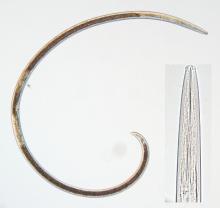See:
Grape (Vitis spp.) - Virus Diseases
Cause Xiphinema americanum, has been found in 85% of the vineyards surveyed in western Oregon, while X. pachtaicum, and/or X. americanum were found in 74% of eastern Washington vineyards. Xiphinema was overall the third-most prominent genus of plant-parasitic nematode found in the Okanagan of BC, being found in 77% of wine grape blocks. Only X. americanum is known to be a vector of Tobacco ringspot virus, which has been reported occasionally on grape in the Pacific Northwest. Dagger nematodes are migratory ectoparasites found only in soil. As virus vectors they can be damaging at very low population levels. Dagger nematode populations may be very low in late summer when other nematodes are abundant.
Symptoms Enlarged root tips and feeder roots may occur, which could result in a witches' broom effect on roots. Yields may be reduced when nematode populations reach high levels.
Sampling The best time to sample for dagger nematodes west of the Cascade Range may be the same as for blueberry or raspberry where populations peak from February to April. If planting grapes, sample during this period to increase the probability of detecting dagger nematodes. In eastern Washington, the best time to sample is at the end of the growing season when populations are highest. Take samples 1 ft from the vine and in the vine row. Remove the top 2 to 3 inches of soil and sample 1 ft deep with a soil tube 1 inch in diameter. Take 10 to 20 subsamples in a given area and combine into one sample. Yield loss in eastern Washington has been associated with population densities greater than 25 X. pachtaicum per 250 cc of soil. No significant yield losses have been observed when X. americanum was present in established Oregon vineyards.
Cultural control If the virus is not present, the nematode by itself may not be a problem.
- Practice good weed control to prevent virus introduction and/or spread.
- Plant only rootstocks and/or scions that have been tested and found to be free of all known viruses.
- Preplant Anaerobic Soil Disinfestation may be helpful even in the PNW. First rice bran is incorporated into the soil followed by irrigation to near field capacity. Then place clear oxygen impermeable plastic (such as anti-condensation film) on the prepared ground. This summer treatment needs to reach soil temperatures of 90F. Use in combination with other techniques.
Chemical control The key in managing nematodes on perennial crops such as grape is to protect new roots from nematode feeding. This allows roots to establish to the point they can tolerate nematode feeding after the chemical's effects dissipate.
Preplant fumigation: Check labels for buffer zone requirements. Preplant fumigation was effective in eastern Washington where dagger nematodes were not detected in plots for 3.5 years.
- 1,3-dichloropropene which is available in various formulations including: Telone II (97% 1,3-D), C-17 (17:81% chloropicrin:1,3-D), and C-35 (35:63% chloropicrin:1,3-D). Soil conditions where grapes are grown are often not conducive for optimum performance of this fumigant in the PNW. Check label for rates and proper ground preparation before application. 5-day reentry. Restricted-use Pesticide.
- Metam sodium-generating products such as Basamid G or Vapam HL. Rates will depend on soil type. Converting the active ingredient into the gaseous phase depends primarily on soil moisture and temperature; follow the label carefully. In the PNW, if application is made in the spring wait up to 21 days before planting to avoid phytotoxicity. 5-day reentry. Restricted-use pesticide.
- Salibro at 30.7 to 61.4 fl oz/A can be used AT planting for non-bearing vines. May be applied using drip or micro-sprinkler irrigation, drench or soil spray followed by irrigation. Group N-UN nematicide. 12-hr reentry.
Postplant chemical use:
- Ecozin Plus at 25 to 56 oz/A through a drip irrigation system. Label suggests using additives to aid penetration into the soil and to make applications in the morning. Efficacy in the Pacific Northwest is unknown. 4-hr reentry. O
- Nema-Q at 1.5 to 3 gal/A for the first application followed by 5 to 10 regular applications at 2 quarts/A. Efficacy in the Pacific Northwest is unknown. 24-hr reentry. O
References East, K. E., Zasada, I. A., Tarara, J. and Moyer, M. M. 2021. Field performance of winegrape rootstocks and fumigation during establishment of a Chardonnay vineyard in Washington. American Journal of Enology and Viticulture, 72:113-125.
Forge, T., Munro, P., Midwood, A. J., Philips, L., Hannam, K., Neilsen, D., Powers, T. and Zasada, I. 2021. Shifting Prevalence of Plant-Parasitic Nematodes in Orchards and Vineyards of the Okanagan Valley, British Columbia. Plant Health Progress. https://doi.org/10.1094/PHP-10-20-0079-RS


